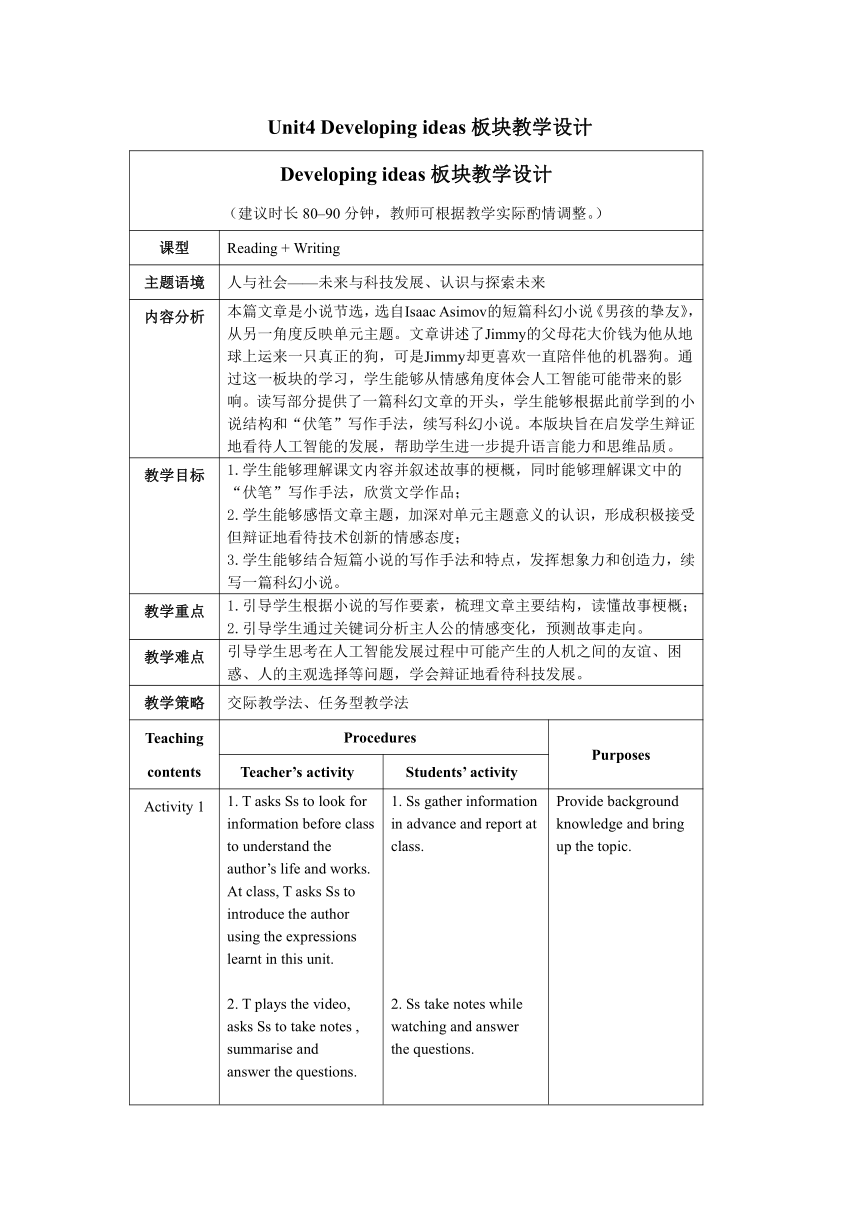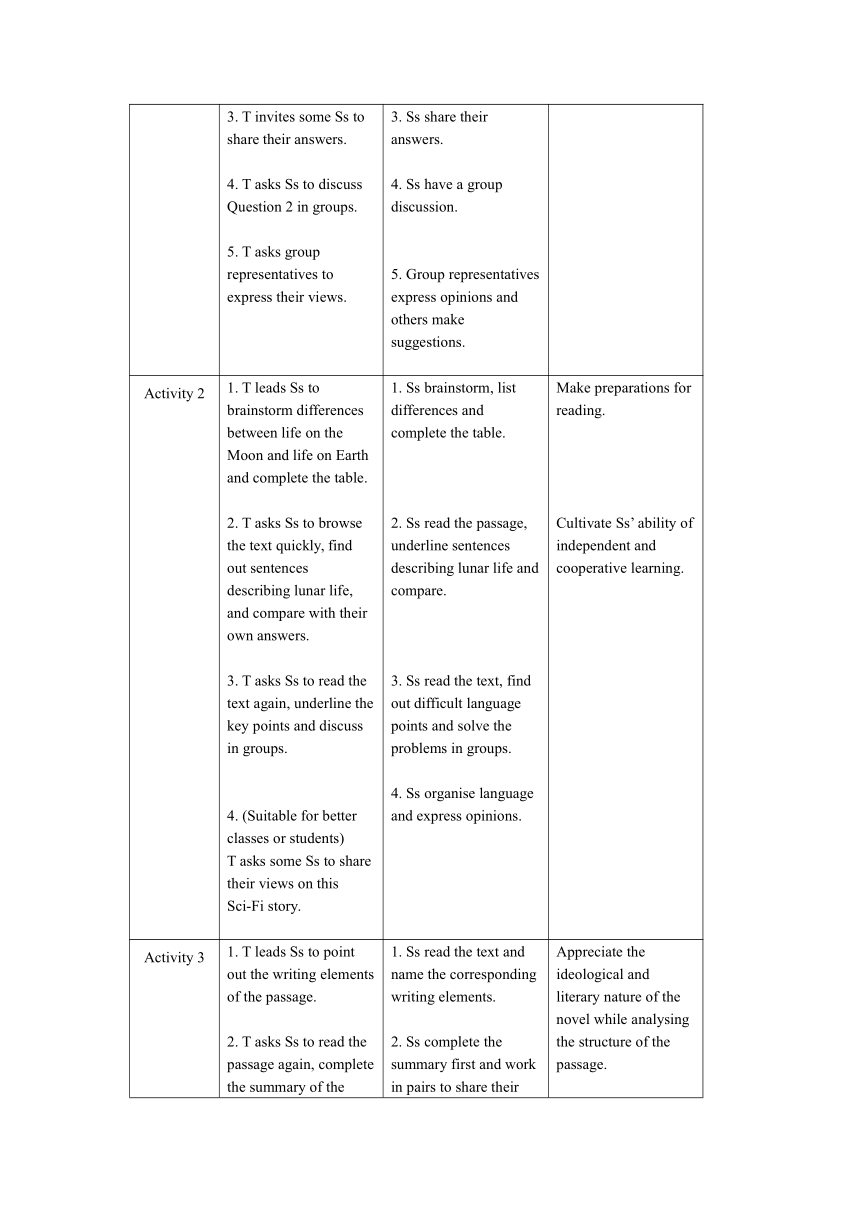外研版(2019)选择性必修第三册 Unit4 A glimpse of the future Developing ideas板块教学设计
文档属性
| 名称 | 外研版(2019)选择性必修第三册 Unit4 A glimpse of the future Developing ideas板块教学设计 |

|
|
| 格式 | docx | ||
| 文件大小 | 17.6KB | ||
| 资源类型 | 教案 | ||
| 版本资源 | 外研版(2019) | ||
| 科目 | 英语 | ||
| 更新时间 | 2023-03-06 19:05:05 | ||
图片预览


文档简介
Unit4 Developing ideas板块教学设计
Developing ideas板块教学设计 (建议时长80–90分钟,教师可根据教学实际酌情调整。)
课型 Reading + Writing
主题语境 人与社会——未来与科技发展、认识与探索未来
内容分析 本篇文章是小说节选,选自Isaac Asimov的短篇科幻小说《男孩的挚友》,从另一角度反映单元主题。文章讲述了Jimmy的父母花大价钱为他从地球上运来一只真正的狗,可是Jimmy却更喜欢一直陪伴他的机器狗。通过这一板块的学习,学生能够从情感角度体会人工智能可能带来的影响。读写部分提供了一篇科幻文章的开头,学生能够根据此前学到的小说结构和“伏笔”写作手法,续写科幻小说。本版块旨在启发学生辩证地看待人工智能的发展,帮助学生进一步提升语言能力和思维品质。
教学目标 1.学生能够理解课文内容并叙述故事的梗概,同时能够理解课文中的“伏笔”写作手法,欣赏文学作品; 2.学生能够感悟文章主题,加深对单元主题意义的认识,形成积极接受但辩证地看待技术创新的情感态度; 3.学生能够结合短篇小说的写作手法和特点,发挥想象力和创造力,续写一篇科幻小说。
教学重点 1.引导学生根据小说的写作要素,梳理文章主要结构,读懂故事梗概; 2.引导学生通过关键词分析主人公的情感变化,预测故事走向。
教学难点 引导学生思考在人工智能发展过程中可能产生的人机之间的友谊、困惑、人的主观选择等问题,学会辩证地看待科技发展。
教学策略 交际教学法、任务型教学法
Teaching contents Procedures Purposes
Teacher’s activity Students’ activity
Activity 1 1. T asks Ss to look for information before class to understand the author’s life and works. At class, T asks Ss to introduce the author using the expressions learnt in this unit. 2. T plays the video, asks Ss to take notes , summarise and answer the questions. 3. T invites some Ss to share their answers. 4. T asks Ss to discuss Question 2 in groups. 5. T asks group representatives to express their views. 1. Ss gather information in advance and report at class. 2. Ss take notes while watching and answer the questions. 3. Ss share their answers. 4. Ss have a group discussion. 5. Group representatives express opinions and others make suggestions. Provide background knowledge and bring up the topic.
Activity 2 1. T leads Ss to brainstorm differences between life on the Moon and life on Earth and complete the table. 2. T asks Ss to browse the text quickly, find out sentences describing lunar life, and compare with their own answers. 3. T asks Ss to read the text again, underline the key points and discuss in groups. 4. (Suitable for better classes or students) T asks some Ss to share their views on this Sci-Fi story. 1. Ss brainstorm, list differences and complete the table. 2. Ss read the passage, underline sentences describing lunar life and compare. 3. Ss read the text, find out difficult language points and solve the problems in groups. 4. Ss organise language and express opinions. Make preparations for reading. Cultivate Ss’ ability of independent and cooperative learning.
Activity 3 1. T leads Ss to point out the writing elements of the passage. 2. T asks Ss to read the passage again, complete the summary of the story independently and check in pairs. 3. T asks some Ss to share their answers. 4. T invites some Ss to talk about their views on Robutt. 5. (Suitable for better classes or students) T asks Ss to consider what might happen next and share their views with the class. 1. Ss read the text and name the corresponding writing elements. 2. Ss complete the summary first and work in pairs to share their answers. 3. Ss share their answers. 4. Ss listen and express views. 5. Ss express ideas. Appreciate the ideological and literary nature of the novel while analysing the structure of the passage.
Think & Share 1. T asks Ss to discuss the four questions in “Think & Share”. 2. T invites some Ss to share their opinions. Ss discuss the four questions in groups and then share their opinions with the class. Focus on the application of foreshadowing and the connection between the two texts.
Activity 4 Method 1: (Suitable for average-level classes or students) 1. T guides Ss to review Jimmy and his parents’ different attitudes towards robot dog summarised in Activity 3 and analyse the reasons. 2. T asks Ss to make the choice if they were Jimmy and state the reasons. 3. T asks Ss to complete the table independently and share the answers in pairs. 4. T invites some Ss to share their answers with the class. Method 2: (Suitable for better classes or students) 1. T asks Ss to discuss the first two questions in Step1 in pairs and share with the class. 2. T asks Ss to brainstorm, list the pros and cons of robot friends. T asks Ss to list at least three supporting or opposing reasons to talk about whether robots and humans can have a true friendship. 3. T asks Ss to work in pairs, choose the opinion and have a debate. 4. T invites some Ss to perform to the class. 1. Students review the text, analyse reasons and report opinions. 2. Ss make choices and state reasons. 3. Ss organise the main points, complete the table and share with partners. 4. Ss share answers. 1. Students do pair work and report their answers. 2. Ss brainstorm and list their opinions. 3. Ss choose the opinion, organise the reasons and debate with the partners. 4. Ss perform the debate to the class. Summarise the theme of the unit and cultivate Ss’ thinking ability.
Activity 5 1. T leads Ss to review the use of foreshadowing in the text. 2. T asks Ss to read the story, talk about three questions in Activity 5 and discuss in pairs. 3. T invites some Ss to share their answers. 1. Ss read the passage and experience the use of foreshadowing. 2. Ss read the story and discuss in pairs. 3. Ss share their answers. Learn the writing techniques and pave the way for writing task.
Activity 6-7 1. T asks Ss to brainstorm and predict the following story. 2. T asks Ss to complete the notes for Activity 6 based on the information given in Activity 5. 3. T asks Ss to continue the story independently with the notes in Activity 6. 4. T asks Ss to exchange stories and help partners to improve the writing. 5. T invites some Ss to share their stories. 1. Ss offer ideas about what will happen next. 2. Ss complete the notes to plan the rest of the story. 3. Ss finish writing the story independently. 4. Ss exchange stories, correct possible errors and promote the language. 5. Ss share stories and give comments. Apply the languageskills and writing strategies learnt in this unit to practice.
Developing ideas板块教学设计 (建议时长80–90分钟,教师可根据教学实际酌情调整。)
课型 Reading + Writing
主题语境 人与社会——未来与科技发展、认识与探索未来
内容分析 本篇文章是小说节选,选自Isaac Asimov的短篇科幻小说《男孩的挚友》,从另一角度反映单元主题。文章讲述了Jimmy的父母花大价钱为他从地球上运来一只真正的狗,可是Jimmy却更喜欢一直陪伴他的机器狗。通过这一板块的学习,学生能够从情感角度体会人工智能可能带来的影响。读写部分提供了一篇科幻文章的开头,学生能够根据此前学到的小说结构和“伏笔”写作手法,续写科幻小说。本版块旨在启发学生辩证地看待人工智能的发展,帮助学生进一步提升语言能力和思维品质。
教学目标 1.学生能够理解课文内容并叙述故事的梗概,同时能够理解课文中的“伏笔”写作手法,欣赏文学作品; 2.学生能够感悟文章主题,加深对单元主题意义的认识,形成积极接受但辩证地看待技术创新的情感态度; 3.学生能够结合短篇小说的写作手法和特点,发挥想象力和创造力,续写一篇科幻小说。
教学重点 1.引导学生根据小说的写作要素,梳理文章主要结构,读懂故事梗概; 2.引导学生通过关键词分析主人公的情感变化,预测故事走向。
教学难点 引导学生思考在人工智能发展过程中可能产生的人机之间的友谊、困惑、人的主观选择等问题,学会辩证地看待科技发展。
教学策略 交际教学法、任务型教学法
Teaching contents Procedures Purposes
Teacher’s activity Students’ activity
Activity 1 1. T asks Ss to look for information before class to understand the author’s life and works. At class, T asks Ss to introduce the author using the expressions learnt in this unit. 2. T plays the video, asks Ss to take notes , summarise and answer the questions. 3. T invites some Ss to share their answers. 4. T asks Ss to discuss Question 2 in groups. 5. T asks group representatives to express their views. 1. Ss gather information in advance and report at class. 2. Ss take notes while watching and answer the questions. 3. Ss share their answers. 4. Ss have a group discussion. 5. Group representatives express opinions and others make suggestions. Provide background knowledge and bring up the topic.
Activity 2 1. T leads Ss to brainstorm differences between life on the Moon and life on Earth and complete the table. 2. T asks Ss to browse the text quickly, find out sentences describing lunar life, and compare with their own answers. 3. T asks Ss to read the text again, underline the key points and discuss in groups. 4. (Suitable for better classes or students) T asks some Ss to share their views on this Sci-Fi story. 1. Ss brainstorm, list differences and complete the table. 2. Ss read the passage, underline sentences describing lunar life and compare. 3. Ss read the text, find out difficult language points and solve the problems in groups. 4. Ss organise language and express opinions. Make preparations for reading. Cultivate Ss’ ability of independent and cooperative learning.
Activity 3 1. T leads Ss to point out the writing elements of the passage. 2. T asks Ss to read the passage again, complete the summary of the story independently and check in pairs. 3. T asks some Ss to share their answers. 4. T invites some Ss to talk about their views on Robutt. 5. (Suitable for better classes or students) T asks Ss to consider what might happen next and share their views with the class. 1. Ss read the text and name the corresponding writing elements. 2. Ss complete the summary first and work in pairs to share their answers. 3. Ss share their answers. 4. Ss listen and express views. 5. Ss express ideas. Appreciate the ideological and literary nature of the novel while analysing the structure of the passage.
Think & Share 1. T asks Ss to discuss the four questions in “Think & Share”. 2. T invites some Ss to share their opinions. Ss discuss the four questions in groups and then share their opinions with the class. Focus on the application of foreshadowing and the connection between the two texts.
Activity 4 Method 1: (Suitable for average-level classes or students) 1. T guides Ss to review Jimmy and his parents’ different attitudes towards robot dog summarised in Activity 3 and analyse the reasons. 2. T asks Ss to make the choice if they were Jimmy and state the reasons. 3. T asks Ss to complete the table independently and share the answers in pairs. 4. T invites some Ss to share their answers with the class. Method 2: (Suitable for better classes or students) 1. T asks Ss to discuss the first two questions in Step1 in pairs and share with the class. 2. T asks Ss to brainstorm, list the pros and cons of robot friends. T asks Ss to list at least three supporting or opposing reasons to talk about whether robots and humans can have a true friendship. 3. T asks Ss to work in pairs, choose the opinion and have a debate. 4. T invites some Ss to perform to the class. 1. Students review the text, analyse reasons and report opinions. 2. Ss make choices and state reasons. 3. Ss organise the main points, complete the table and share with partners. 4. Ss share answers. 1. Students do pair work and report their answers. 2. Ss brainstorm and list their opinions. 3. Ss choose the opinion, organise the reasons and debate with the partners. 4. Ss perform the debate to the class. Summarise the theme of the unit and cultivate Ss’ thinking ability.
Activity 5 1. T leads Ss to review the use of foreshadowing in the text. 2. T asks Ss to read the story, talk about three questions in Activity 5 and discuss in pairs. 3. T invites some Ss to share their answers. 1. Ss read the passage and experience the use of foreshadowing. 2. Ss read the story and discuss in pairs. 3. Ss share their answers. Learn the writing techniques and pave the way for writing task.
Activity 6-7 1. T asks Ss to brainstorm and predict the following story. 2. T asks Ss to complete the notes for Activity 6 based on the information given in Activity 5. 3. T asks Ss to continue the story independently with the notes in Activity 6. 4. T asks Ss to exchange stories and help partners to improve the writing. 5. T invites some Ss to share their stories. 1. Ss offer ideas about what will happen next. 2. Ss complete the notes to plan the rest of the story. 3. Ss finish writing the story independently. 4. Ss exchange stories, correct possible errors and promote the language. 5. Ss share stories and give comments. Apply the languageskills and writing strategies learnt in this unit to practice.
